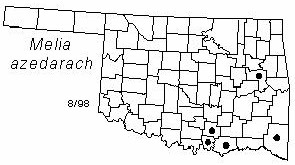Tree to 12 m (40 ft) tall with spreading round dense crown. Twigs thick, glabrous, green to brown, with small rounded axillary buds, no end bud. Bark reddish brown, smooth on young branches, later becoming divided into broad forking ridges. Leaves bipinnately compound, 20-45 cm (8-18 in) long, with thin green stalk and few paired forks. Leaflets numerous, paired except at end, 2.5-5 cm (1-2 in) long and 1-2 cm (0.4-0.8 in) wide, acuminate, usually serrate, dark green, with strong odor when crushed. Flowers numerous, small, fragrant, pale purple, in panicles 10-25 cm (4-10 in) long. Fruits numerous drupes, yellowish, poisonous, about 15 mm (0.6 in) in diameter, remaining attached in winter.
Distribution: Native to east Asia, but naturalized in many subtropical and warm-temperate areas.
Habitat: Disturbed areas, roadsides, old homesites, forest margins
NWI status: none
Comment: All parts of the tree are poisonous. The fruits have been used as insect repellent. Melia is an old Greek name; azedarach is an old Persian name.
Distribution in Oklahoma: 
BACK
NEXT
RETURN TO INDEX
Last update: 9/14/99
 Go to Oklahoma Biological Survey Home Page
Go to Oklahoma Biological Survey Home Page
 Disclaimer
Disclaimer